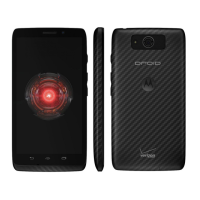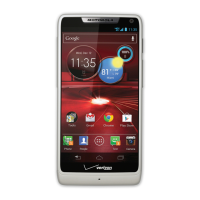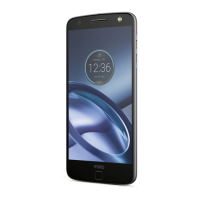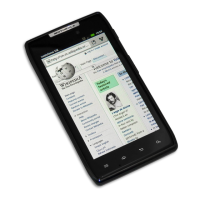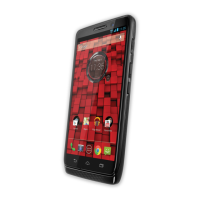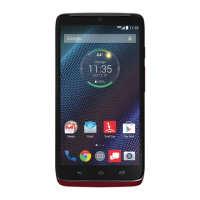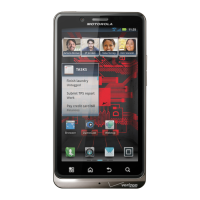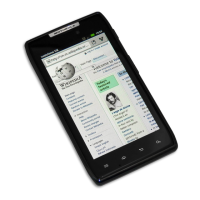Do you have a question about the Motorola Droid Maxx 2 and is the answer not in the manual?
Introduces the phone's basic features and initial setup.
Provides helpful tips and hints for basic phone usage.
Accessing frequently used phone settings quickly.
Customizing the phone's main display.
Guide to installing SIM/microSD and powering up.
Strategies to improve battery longevity and performance.
Guidance on network and account setup during initial use.
Steps for transferring data to a new device.
Overview of the home screen and app access.
Navigation and shortcut tips for the home screen.
Locating help resources and tutorials on the phone.
Understanding status bar icons and notifications.
Explanation of phone status icons.
Introduction to Motorola's app ecosystem.
How to get applications from Google Play.
App safety and installation advice.
Managing app resource consumption.
Checking for and installing software updates.
Basic control and personalization features.
Using voice commands for interaction.
Accessing settings via status bar gestures.
Adjusting ringtone sound levels.
Controlling media playback volume.
Using voice for text input.
Customizing lock screen notification display.
Adjusting screen brightness and appearance.
Controlling screen orientation.
Placing widgets on the home screen.
Adjusting widget dimensions.
Using voice commands for phone operations.
Reading text content aloud.
Touch gesture feedback for visually impaired users.
Installing BrailleBack for Braille display support.
Configuring sound and vibration levels.
Enhancing text visibility for readability.
Enabling vibration feedback for keyboard input.
Features for easier text input.
Accessing the app store.
Basic call functions overview.
How to receive incoming calls.
Using other apps while on a call.
Important information on emergency call functionality.
Introduction to managing contacts.
Entering contact details and saving them.
Methods for importing contact information.
Modifying existing contact information.
Assigning custom ringtones to contacts.
Removing contacts from the list.
Importing contacts from SIM.
Overview of the messaging application.
Composing new text messages.
Adding media to messages.
Adding emoticons to messages.
Sending voice messages.
Responding to received messages.
Resending messages to others.
Managing email accounts within Gmail.
Adding new Google email accounts.
Characteristics of emergency alerts.
Introduction to text input methods.
Different ways to enter text.
Precise text cursor placement.
Selecting the input keyboard.
Using the clock application.
Setting and managing alarms.
Overview of calendar entries.
Cloud storage for files.
Creating content in Drive.
Exploring Google's digital content store.
Personalized information service.
Accessing video content.
Introduction to web browsing.
Navigating to websites.
Creating shortcuts for websites.
Establishing a Wi-Fi connection.
Private browsing mode.
Erasing browsing records.
Introduction to camera features.
Quickly opening the camera.
Gesture-based camera activation.
Filming video clips.
Modifying captured photos.
Capturing wide-angle scenes.
Selecting storage for media.
Introduction to the music player.
Multitasking with music playback.
Using GPS for navigation.
Searching for locations using Maps.
Locating specific addresses on the map.
Obtaining turn-by-turn navigation.
Connecting external devices.
Pairing with Bluetooth accessories.
Connecting to wireless networks.
Creating a personal Wi-Fi hotspot.
Enabling/disabling Wi-Fi.
Finding and joining available networks.
Security recommendations for hotspots.
Monitoring mobile data consumption.
Functionality of NFC.
Sharing content using NFC.
Phone data encryption for security.
Sharing media with nearby users.
Sending media from the gallery.
Synchronizing data across devices.
Managing external storage.
Configuring VPN connections.
Functionality and use of airplane mode.
Overview of phone protection features.
Setting up screen lock for security.
Using a PIN for unlock.
Locking an app to the screen.
Important warning about encryption.
Performing a factory data reset.
Accessing support and additional information.
Obtaining PC software and guides.
Company contact and address details.
Introduces the phone's basic features and initial setup.
Provides helpful tips and hints for basic phone usage.
Accessing frequently used phone settings quickly.
Customizing the phone's main display.
Guide to installing SIM/microSD and powering up.
Strategies to improve battery longevity and performance.
Guidance on network and account setup during initial use.
Steps for transferring data to a new device.
Overview of the home screen and app access.
Navigation and shortcut tips for the home screen.
Locating help resources and tutorials on the phone.
Understanding status bar icons and notifications.
Explanation of phone status icons.
Introduction to Motorola's app ecosystem.
How to get applications from Google Play.
App safety and installation advice.
Managing app resource consumption.
Checking for and installing software updates.
Basic control and personalization features.
Using voice commands for interaction.
Accessing settings via status bar gestures.
Adjusting ringtone sound levels.
Controlling media playback volume.
Using voice for text input.
Customizing lock screen notification display.
Adjusting screen brightness and appearance.
Controlling screen orientation.
Placing widgets on the home screen.
Adjusting widget dimensions.
Using voice commands for phone operations.
Reading text content aloud.
Touch gesture feedback for visually impaired users.
Installing BrailleBack for Braille display support.
Configuring sound and vibration levels.
Enhancing text visibility for readability.
Enabling vibration feedback for keyboard input.
Features for easier text input.
Accessing the app store.
Basic call functions overview.
How to receive incoming calls.
Using other apps while on a call.
Important information on emergency call functionality.
Introduction to managing contacts.
Entering contact details and saving them.
Methods for importing contact information.
Modifying existing contact information.
Assigning custom ringtones to contacts.
Removing contacts from the list.
Importing contacts from SIM.
Overview of the messaging application.
Composing new text messages.
Adding media to messages.
Adding emoticons to messages.
Sending voice messages.
Responding to received messages.
Resending messages to others.
Managing email accounts within Gmail.
Adding new Google email accounts.
Characteristics of emergency alerts.
Introduction to text input methods.
Different ways to enter text.
Precise text cursor placement.
Selecting the input keyboard.
Using the clock application.
Setting and managing alarms.
Overview of calendar entries.
Cloud storage for files.
Creating content in Drive.
Exploring Google's digital content store.
Personalized information service.
Accessing video content.
Introduction to web browsing.
Navigating to websites.
Creating shortcuts for websites.
Establishing a Wi-Fi connection.
Private browsing mode.
Erasing browsing records.
Introduction to camera features.
Quickly opening the camera.
Gesture-based camera activation.
Filming video clips.
Modifying captured photos.
Capturing wide-angle scenes.
Selecting storage for media.
Introduction to the music player.
Multitasking with music playback.
Using GPS for navigation.
Searching for locations using Maps.
Locating specific addresses on the map.
Obtaining turn-by-turn navigation.
Connecting external devices.
Pairing with Bluetooth accessories.
Connecting to wireless networks.
Creating a personal Wi-Fi hotspot.
Enabling/disabling Wi-Fi.
Finding and joining available networks.
Security recommendations for hotspots.
Monitoring mobile data consumption.
Functionality of NFC.
Sharing content using NFC.
Phone data encryption for security.
Sharing media with nearby users.
Sending media from the gallery.
Synchronizing data across devices.
Managing external storage.
Configuring VPN connections.
Functionality and use of airplane mode.
Overview of phone protection features.
Setting up screen lock for security.
Using a PIN for unlock.
Locking an app to the screen.
Important warning about encryption.
Performing a factory data reset.
Accessing support and additional information.
Obtaining PC software and guides.
Company contact and address details.
| Announced | 2015, October |
|---|---|
| Technology | GSM / CDMA / HSPA / LTE |
| GPRS | Yes |
| EDGE | Yes |
| Weight | 169 g (5.96 oz) |
| SIM | Nano-SIM |
| Type | AMOLED capacitive touchscreen, 16M colors |
| Multitouch | Yes |
| Protection | Corning Gorilla Glass 3 |
| OS | Android 5.1.1 (Lollipop), upgradable to 6.0 (Marshmallow) |
| CPU | Octa-core (4x1.7 GHz Cortex-A53 & 4x1.0 GHz Cortex-A53) |
| GPU | Adreno 405 |
| Features | Geo-tagging, touch focus, face detection, panorama, HDR |
| Video | 1080p@30fps |
| Alert types | Vibration; MP3, WAV ringtones |
| Loudspeaker | Yes |
| 3.5mm jack | Yes |
| WLAN | Wi-Fi 802.11 a/b/g/n, dual-band, Wi-Fi Direct, hotspot |
| Bluetooth | 4.0, A2DP, LE |
| GPS | Yes, with A-GPS, GLONASS |
| NFC | Yes |
| Radio | FM radio |
| Sensors | Accelerometer, gyro, proximity, compass |
| Messaging | SMS (threaded view), MMS, Email, Push Email, IM |
| Browser | HTML5 |
| Java | No |
| Battery | Non-removable Li-Ion 3630 mAh battery |
| Talk time | Up to 48 h (3G) |
| Colors | Black |
| 2G bands | GSM 850 / 900 / 1800 / 1900 |
| 3G bands | HSDPA 850 / 900 / 1900 / 2100 |
| 4G bands | LTE band 2(1900), 4(1700/2100), 5(850) |
| Speed | LTE Cat4 150/50 Mbps |
| Size | 5.5 inches |
| Resolution | 1080 x 1920 pixels |
| Card slot | microSD |
| Internal | 16 GB, 2 GB RAM |
| Primary | 21 MP, f/2.0 |
| Secondary | 5 MP |
| USB | microUSB 2.0 |
| Status | Available. Released 2015, October |
| Chipset | Qualcomm MSM8939 Snapdragon 615 (28 nm) |
